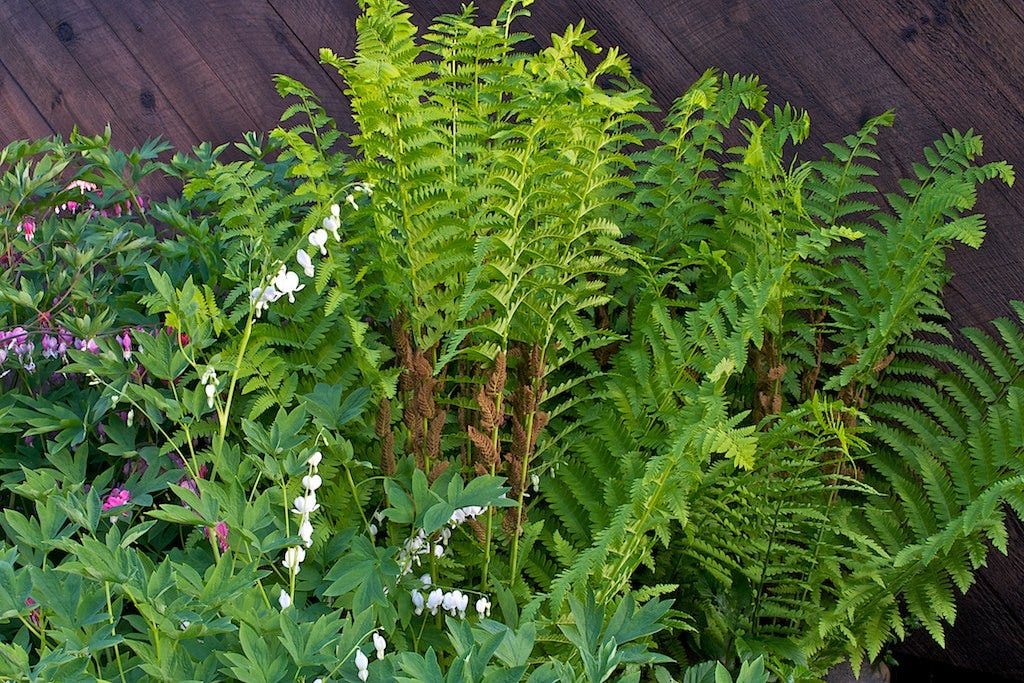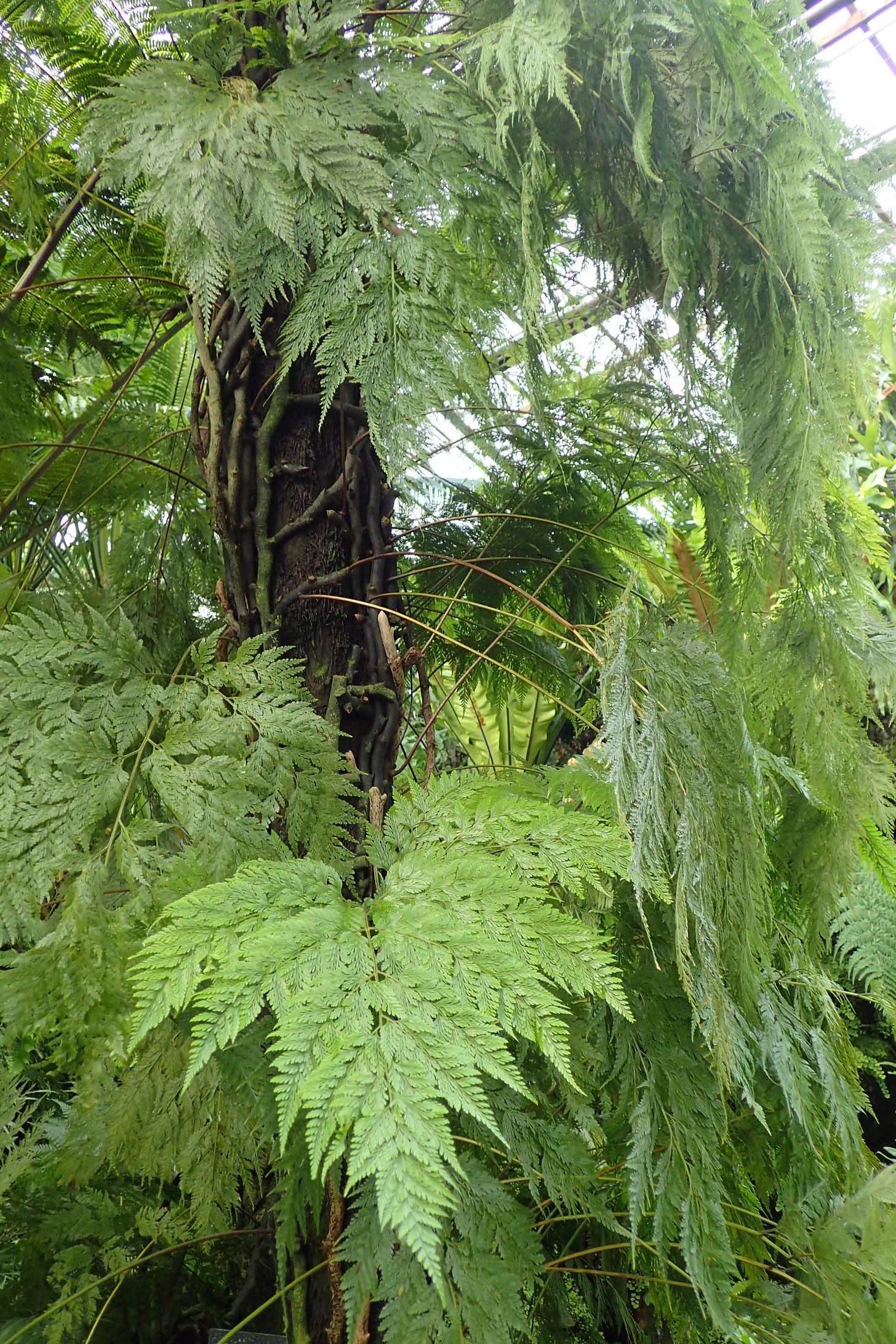Not the cinnamon fern with it’s long rusty fertile frond. (This fern is part of the Osmundaceae family, which also includes one of the best plant names ever, the Interrupted Fern)
Or the terrestrial leatherleaf fern
ALSO KNOWN AS: Davallia fejeensis, squirrel’s foot fern
How you know:
hairy rhizomes
laced fronds looking frothed like moss
a tender green
up in a tree
My research on this particular type of fern brought me to many a dead end. Indeed, the rabbit’s foot fern is an extremely common name to describe any fern that has distinctive crawling rhizomes. The truth about this species is that there are many kinds of davallia, but they are difficult to differentiate, being so similar. After hours online I came up with many splits and knots, and I am still learning. When I start tasking AI to write What’s That Plant?! for me, plants like the davallia fejeensis, will give them a difficult time. They will mix davallia species together. Or the entry will be a single line saying “davallia lives in trees in southern Asia”. I’m kidding! AI is probably way smarter than I am. They will laugh at me as they write a perfectly entertaining and useful article about a little known plant.
But in all seriousness, the amount of information missing about this plant outside of it being a “great houseplant”: its purpose in its ecosystem and the medicine, and stories it uniquely has is jarring, but it reminds me: it is known by someone, by some people, perhaps. When we engage with plants we develop relationships with them, and yet there is an ancient relationship people have already had with them which just is not available online, or even accessible in textbooks. So I write for davallia var solida fejeensis (it’s official name), or rabbit’s foot fern, and encourage you to interact closely with ferns around you, asking what makes them special.
Perhaps ferns need touch, perhaps they need close interaction to know one from the next.
Davallia Fejeensis is epiphytic, meaning it grows above ground. It has frilled fronds that hang down in giant triangular flags. Their rhizomes have brown fur that is known as scales. It’s pinnules are lanced and complex as an optical illusion. Think parsley, except bursting and giant. But the delicacy of their pinnae is notable. How the smooth texture of their skin is also thin as the wing of a butterfly. The rabbit’s foot fern walks, crawls along its host, submerging its softened shoots into and around the structure to which it clings, whether that be a rock or a tree. The sporangia are lined like neat buttons along the fronds in tight groups of sori. So it can grow from rhizomes or spores. But, as you may know, the fern predates the flower, so these will never bloom.
These plants are mostly known for their success as a houseplant because of how low maintenance they are. I found myself watching lots of youtube videos of nice white ladies talk about how they really made their rabbit’s foot grow and how easy it was to just mist the davallia (insert type of davallia species here), which all looked the same to me, and they insisted on calling rabbit’s foot when they had different names. For the most part they like to be left on their own in some partly shady place. Davallia Fejeensis is native to the subtropical Fijian islands. Most ferns enjoy damp shady areas but this grows in the canopy of rainforests where it reaches for the sun, but always dancing with the shade as they would burn under direct light.
Their rhizomatic fur shimmers, incongruous with the lacelike pinnae making the plant look like a tarantula wearing a veil. While they are strong in their wild form, clinging to their trees, their rocks, and cliffs with a true passion; when they are in pots or hanging baskets the young rhizomes stick out like the plant is becoming something else. A creature, unlike its host emerges. I like to imagine it has teeth. The apparent fur is called trichomes. They are a reaction to the oxygen in the air, and a way to keep moisture in the roots. Epiphytic ferns absorb all they can from the nutrients in the air and water dripping down the trees.
Ferns have always been themselves.
They are an ancient group of plant, developing before seed-bearing plants about 400 million years ago when vascular and nonvascular plants separated. Because of this they are highly adaptable and have developed useful ways of surviving in the an ever changing world. One of the ways it has adapted is that it lives twice. Once the spore germinates it becomes a small plant called a gametophyte which is either male or female which then fertilize with another gametophyte to become what we know as a fern, starting with the balled up fiddlehead or koru.
This fern has been used medicinally in ways I can not confirm. I am eighty percent sure the fiddlehead can be eaten, like most fiddleheads of ferns. It is nontoxic to dogs and cats… which makes it a perfect plant to become a tarantula in your house.
myth for rabbit’s foot fern
The fern remembers the shade under the giant primeval trees. They remember the time when there was so much oxygen in the world everything was giant, and life was profound and bubbling over with abundance on this planet. The plants at that time were colossal and ruled all places. Slowly plants were morphing into scaled and feathered animal beings, some, even then, had fur, like the Davallia Fejeensis who was beginning to see, growing out of their roots, small furred legs. Soon the creator of animals would come and whisper a spell of stasis, to allow the once-plants to be animals. But the davallia did not want to transform. It asked all of the transforming plants in the forest to help it before the creator of all animals came. But they dared not. Because they knew if they were to help they might not be able to choose what animal they would become. Many were excited to become birds, and monkeys, jaguars, and moths. So they did nothing.
Finally the davallia asked the trees, and they welcomed the plant up in their slow and quiet way. “But you must hold me, and keep food and water close to me” the tree said. And the spider monkey said, “I will wrap my arms around the tree so that the animal maker gets confused and thinks you are not transforming, if you will let me hide in your shade and eat your fronds.”
The davallia climbed up the tree with the spider monkey and was not seen by the animal maker.
But the animal within the plant still lives in those thick rhizomes. And sometimes, if you look very closely, you can see those arms tremble, and dance, and embrace the beasts who climb in the trees.
Forager Friendly!
Fiddleheads and are great source of iron and fiber!
Sources:
https://www.youtube.com/watch?v=2TwcO0OLwn8
https://en.wikipedia.org/wiki/Davallia_fejeensis
https://www.hamama.com/blogs/hamama-blog/white-fuzzy-roots-what-s-the-deal








